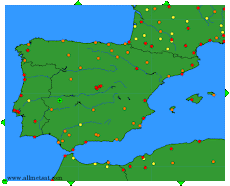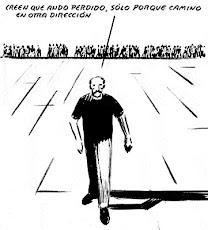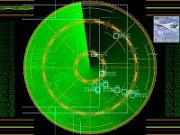domingo, 20 de julio de 2014
ENGINE FAILURE DURING TAKEOFF: A SKYBRARY ARTICLE
Adjuntamos artículo de SKYbrary sobre fallo de motor durante el despegue. Una incidencia que en principio no debe causar mayores problemas, más allá de un buen susto, siempre que los procedimientos de fallo de motor, que son específicos de cada compañía y aprobados por la AESA, no escondan sorpresas y los aviones operen todos los motores; algo tan obvio que si nos dijeran que no es así lo tomaríamos como una broma de muy mal gusto.
Engine Failure During Takeoff - Multi-Engine Transport Category Jet Aircraft
Source: www.skybrary.aero
Categories: Loss of Control | Operational Issues
Description
In the early days of jet engine powered transport aircraft, engine failures, in all phases of flight, were a fairly frequent occurrence. Statistics from the 1960's indicate that failures resulting in inflight shutdowns occurred at an approximate rate of 40 per 100,000 flight hours (or 1 per 2,500 flight hours). This rate is the equivalent of every engine failing once every year. By contrast, the failure rate of the engines installed on current generation aircraft have a failure rate of less than 1 per 100,000 flight hours.
Infrequent as this might seem, engines do fail and a failure during takeoff has very serious safety of flight implications. The aerodynamic effects of the failure and the immediate actions by the flight crew, which are necessary to ensure an acceptable outcome, are similar to those in a light, twin engine aircraft. However, unlike their smaller cousins, the certification criteria for multi-engine transport category jet aircraft require that the aircraft be capable of achieving a specified minimum climb rate, that will ensure obstacle clearance, should an engine failure occur on takeoff.
Regulatory Requirements
The National Aviation Authority (NAA) for each sovereign state is responsible for issuing an aircraft type certificate, in accordance with the guidance provided in the ICAO Standards and Recommended Practices (SARPS), for aircraft that are registered within its jurisdiction. While the SARPS provide the agreed minimum requirements for type certification, each NAA has the right to insist that additional criteria be satisfied before an aircraft type certificate will be issued. Within the EASA states type certificates are issued by the European Aviation Safety Agency
Aircraft Type Certification
There are many safety and performance requirements that must be met before an aircraft will be issued a type certificate. For multi-engine, transport category jet aircraft, minimum runway requirements that allow the safe rejection or continuation of a takeoff in the event of a failure and the ability to comply with minimum specified engine out climb gradients and obstacle clearance criteria are both critically important.
Minimum Runway Requirements
Regulatory criteria for minimum runway requirements encompass multiple calculations inclusive of Takeoff Distance (TOD), Takeoff Run (TOR) and Accelerate Stop Distance (ASD). The most limiting of these criteria, based on aircraft weight and prevailing atmospheric conditions, defines the minimum runway required for takeoff. Note that, depending upon the regulations under which the aircraft certification is granted, these distances may have to take into consideration the runway distance lost during line-up.
Declared Distances
Takeoff Distance (TOD)
The Takeoff Distance on a dry runway is the greater of the following values:
• Distance covered from the brake release to a point at which the aircraft is 35 feet above the takeoff surface, assuming the failure of the critical engine at VEF (Engine Failure Speed) and recognized at V1
• 115% of the distance covered from brake release to a point at which the aircraft is 35 feet above the takeoff surface, assuming all engines operating
The Takeoff Distance on a wet runway is the greater of:
• Takeoff Distance on a dry runway (see above)
• Distance covered from brake release to a point at which the aircraft is 15 feet above the takeoff surface, ensuring that the V2 speed can be achieved before the airplane is 35 feet above the takeoff surface, assuming failure of the critical engine at VEF and recognized at V1
Takeoff Distance must not exceed the Takeoff Distance Available (TODA), with a clearway distance not to exceed half of the TODA
Takeoff Run (TOR)
Takeoff Run (TOR) calculations incorporate the operational advantage of a designated clearway when one is present on the departure runway. If no clearway exists, TOR = TOD.
When a clearway exists, the Takeoff Run on a dry runway is the greater of the following values:
• Distance covered from brake release to a point equidistant between the point at which VLOF (Lift-off Speed) is reached and the point at which the aircraft is 35 feet above the takeoff surface, assuming failure of the critical engine at VEF and recognized at V1
• 115 % of the distance covered from brake release to a point equidistant between the point at which VLOF is reached and the point at which the aircraft is 35 feet above the takeoff surface, assuming all engines operating
When a clearway exists, the Takeoff Run on a wet runway is the greater of:
• Takeoff Distance (TOD) wet runway
• 115 % of the distance covered from brake release to a point equidistant between the point at which VLOF is reached and the point at which the aircraft is 35 feet above the takeoff surface, assuming all engines operating.
Takeoff Run must not exceed Takeoff Run Available (TORA)
Accelerate Stop Distance (ASD)
Accelerate Stop Distance calculations assume the following:
• Delay between VEF and V1 = 1 second
• ASD is determined with the wheel brakes at the fully worn limit of their allowable wear range
• reverse thrust is not considered for a dry runway distance determination, it can be used for wet runway calculations
The Accelerate Stop Distance on a dry runway is the greater of the following values:
• Sum of the distances necessary to:
1.Accelerate the airplane with all engines operating to VEF
2.Accelerate from VEF to V1 (assumes that engine fails at VEF and first action to reject is taken at V1)
3.Come to a full stop
4.Plus an additional distance equivalent to 2 seconds at constant V1 speed
• Sum of the distances necessary to:
1.Accelerate the airplane with all engines operating to V1 (assumes that first stopping actions are taken at V1)
2.With all engines still operating come to a full stop
3.Plus an additional distance equivalent to 2 seconds at constant V1 speed
The Accelerate Stop Distance on a wet runway is the greatest of:
• ASD on a dry runway (see above)
• Sum of the distances on a wet runway necessary to:
1.Accelerate the airplane with all engines operating to VEF
2.Accelerate from VEF to V1 (assumes that engine fails at VEF and first action to reject is taken at V1)
3.Come to a full stop
4.Plus an additional distance equivalent to 2 seconds at constant V1 speed
• Sum of the distances on a wet runway necessary to:
1.Accelerate the airplane with all engines operating to V1 (assumes that first stopping actions are taken at V1)
2.With all engines still operating come to a full stop
3.Plus an additional distance equivalent to 2 seconds at constant V1 speed
Note: Depending upon the criteria under which the aircraft was certified, the additional 2 seconds distance equivalent might not be required
Accelerate Stop Distance must not exceed the Accelerate Stop Distance Available (ASDA)
Loss of Runway Length During Lineup
Declared distances such as TORA and ASDA are based on measurements from the runway threshold. However, unless the aircraft enters the runway from a point prior to the threshold, it is not possible to use the full length of the runway. Aircraft typically enter the takeoff runway from an intersecting taxiway. The aeroplane must then be turned to align it on the runway in the direction of takeoff. In some cases, it may be necessary to backtrack on the runway and turn through 180° before the takeoff run can be initiated. FAA regulations do not explicitly require airplane operators to take into account the runway distance used to align the aeroplane on the runway for takeoff. However, EASA regulations require that the applicable distance be taken into consideration. When required, the TODA and TORA must be reduced by the distance from the runway threshold to the main landing gear and ASDA reduced by the distance from the threshold to the nose gear. Manufacturers will provide minimum lineup distances required for both 90° and 180° turns.
Some Operators provide data which takes loss of runway length during lineup into account. All crews must be familiar with the assumptions made in the production of their own company’s data.
Engine Out Obstacle Clearance Profile
The Net Takeoff Flight Path for the engine failure case is divided into four segments. Three of these are climbing segments with specified minimum gradients which are dependent upon the number of engines installed on the aircraft and one is a level acceleration segment. A brief description of the four segments is as follows:
1.First Segment - depending upon the regulations under which the aircraft is certified, the first segment begins either at lift-off or at the end of the takeoff distance at a screen height of 35' and a speed of V2. On a wet runway, the screen height is reduced to 15'. Operating engines are at takeoff thrust, the flaps/slats are in takeoff configuration and landing gear retraction is initiated once safely airborne with positive climb. The first segment ends when the landing gear is fully retracted.
2.Second Segment - begins when the landing gear is fully retracted. Engines are at takeoff thrust and the flaps/slats are in the takeoff configuration. This segment ends at the higher of 400' or specified acceleration altitude. In most cases, the second segment is the performance limiting segment of the climb.
3.Third or Acceleration Segment- begins at the higher of 400' or specified acceleration altitude. Engines are at takeoff thrust and the aircraft is accelerated in level flight. Slats/flaps are retracted on speed. The segment ends when aircraft is in clean configuration and a speed of VFS has been achieved. Note that the third segment must be completed prior to exceeding the maximum time allowed for engines at takeoff thrust.
4.Fourth or Final Segment - begins when the aircraft is in clean configuration and at a speed of VFS. Climb is re-established and thrust is reduced to maximum continuous (MCT). The segment ends at a minimum of 1500' above airport elevation or when the criteria for enroute obstacle clearance have been met.
Each segment of the one engine inoperative takeoff flight path has a mandated climb gradient requirement. For example, a gross second segment climb gradient capability of 2.4%, 2.7% or 3.0% is required for two, three and four engine aircraft respectively. Similarly, the required gross gradients for the fourth segment are 1.2%, 1.5% and 1.7% respectively.
To ensure obstacle clearance while allowing for aircraft performance degradation and less than optimum pilot technique, the gross gradients are reduced by 0.8%, 0.9% and 1.0% respectively to calculate a net gradient. The obstacle identification surface (OIS), or obstruction envelope, starts at runway elevation at a point directly beneath the end of the takeoff distance (TOD) and parallels the net gradient profile of the climb segments. If an obstacle in the departure path penetrates the OIS, the slope of the OIS must be increased and both the net and the gross gradient slopes of the corresponding segment must also be increased to ensure that the minimum obstacle clearance criteria is met.
The aircraft net gradient capability, correctable for temperature, altitude and pressure, is published in the AFM performance data and, in actual operations, must ensure that the limiting obstacle in the departure path can be cleared by a minimum of 35'. If there is an obstacle within the departure path that cannot be avoided and would not be cleared by 35', the planned takeoff weight must be reduced until minimum obstacle clearance can be achieved. Note that, by regulation, turns immediately after takeoff cannot be initiated below the greater of 50'AGL or one half of the aircraft wingspan and, that during the initial climb, turns are limited to 15° of bank. Turning will result in a reduction in aircraft climb capability.
Take off Flight Path
To maximise the payload capability from any given runway, most operators develop and utilize emergency turn procedures. These procedures follow a specified ground track which minimises the affects of local obstacles and a specified vertical profile which complies with the more restrictive of certification or actual obstacle climb requirements.
Effects of Engine Failure
On the Runway
If a multi-engine aircraft suffers an engine failure during the takeoff roll, the aircraft will yaw towards the failed engine. If the airspeed at the time of the failure is at or above Vminimum control ground (Vmcg), directional control on the runway can be maintained utilizing only aerodynamic controls. At a speed below Vmcg, directional control will not be possible unless thrust on the operating engine(s) is (are) also reduced. In any event, if the airspeed at the time that the failure is recognised is less than V1, the takeoff must be rejected.
Airborne
If a multi-engine aircraft suffers an engine failure when airborne, there are two immediate aerodynamic effects. The initial effect is the yawing that occurs due to the asymmetry of the thrust line. The size of this initial yawing moment depends upon the engine thrust and the distance between the thrust line and the aircraft centre of gravity. The yawing moment is also affected initially by the rate of thrust decay of the ‘dead’ engine and ultimately by its drag.
The second effect is roll. This occurs when the aircraft continues to yaw towards the failed engine resulting in a decrease in lift from the ‘retreating’ wing and a yaw-induced roll towards the failed engine.
As well as the aerodynamic consequences of the failure, the performance penalty is very significant. While the failure of an engine in a twin engine aircraft represents a 50% loss of available power, it will result in a more than 50% loss of performance.
Flight Crew Actions
During pre-flight preparation:
• Using the Electronic Flight Bag or the appropriate performance charts, determine the maximum takeoff weight (MTOW) for the runway in use, anticipated atmospheric conditions and intended aircraft configuration
• Confirm that actual aircraft weight does not exceed the calculated maximum allowable weight
• Complete performance calculations to determine speeds and thrust settings (inclusive of reduced thrust criteria where appropriate or applicable)
• Review and brief the Emergency Turn procedure inclusive of routing, turns and turn altitudes, acceleration altitude and safe altitudes
During the takeoff roll:
• Use appropriate lineup technique to ensure charted runway length is available
• Apply thrust using manufacturer's recommended procedures
• Confirm actual thrust meets or exceeds calculated thrust
• In the event of an engine failure prior to V1, reject the takeoff
o ADVISE Air Traffic Control (ATC) that the takeoff has been rejected using appropriate emergency communication protocols
In the event of an engine failure after V1:
• Establish and maintain directional control with appropriate rudder input
• Rotate at Vr and establish a climb speed of V2
o If the failure occurs after the aircraft is airborne, a climb speed of between V2 and V2 + 10 is acceptable
• Utilise appropriate aileron input to maintain wings level. At, or near, VMinimum Control Air (Vmca), as much as a 5° bank away from the dead engine may be required
• When safely airborne and established in a positive climb, retract the landing gear
o Establish or maintain the Emergency Turn routing
• Initiate ECAM / EICAS / Emergency Checklist procedures as per manufacturer and Company policy
o Establish or maintain the Emergency Turn routing
• Maintain V2 and takeoff thrust until reaching acceleration altitude. Acceleration altitude will be the highest of 400' AGL, Emergency Turn procedure published acceleration altitude or Company standard acceleration altitude
o Establish or maintain the Emergency Turn routing
• At acceleration altitude, maintain takeoff thrust, level the aircraft (see note below) and accelerate to VFS retracting flaps on schedule.
o Establish or maintain the Emergency Turn routing
• Once in clean configuration, maintain VFS, resume climb and reduce thrust to maximum continuous
o Establish or maintain the Emergency Turn routing
• ADVISE ATC using appropriate emergency communication protocols
o note that if the Emergency Turn profile has or will result in a departure from the cleared routing, ATC should be notified as soon as it is practical to do so
• Reaching a safe altitude, comply with any enroute climb requirements, complete any appropriate emergency or QRH checklists, determine plan of action (diversion or recovery) and advise ATC
Note: The acceleration profiles utilised by VNAV and FLCH modes do not necessarily command the aircraft to fly level at Acceleration altitude in the event of an engine failure. With all engines operating, VNAV & FLCH will use the algorithm 60% climb, 40% acceleration. In the event of an engine failure, the algorithm is reversed with 40% climb, 60% acceleration. As a consequence, at light weights the APFDS may command a climb during the acceleration phase.
Defences
Crew members must make themselves familiar with the explanatory notes to their performance data. Only by gaining an understanding of the assumptions made in the calculations can best use be made of the data.
If aircraft engines were 100% reliable, engine failure during takeoff would never occur. Over the years, manufacturers have made great improvements in the reliability of their products and the failure rate of turbine engines has decreased with each generation. It is unlikely, however, that the potential for engine failure will ever be completely eliminated.
Maintenance personnel can reduce the risk of failure by ensuring that the engines are maintained to the manufacturer’s recommendations. Ground crew and flight crew must ensure during their preflight and postflight inspections that all fluids are adequate, that there are no obvious leaks or damage and that the fuel supply is free from water or other contamination.
Flight crew / dispatch performance calculations must ensure that the aircraft can meet regulatory requirements in the event of an engine failure during the takeoff.
Flight crew should have a thorough understanding of the aerodynamics of a failure and clearly understand the actions that must be taken should a failure occur.
Finally, crews must be completely familiar with their Company procedures which will always take priority.
Related articles and further reading were not included but are available in the skybrary article.
En el Aeropuerto Adolfo Suárez Madrid-Barajas, las maniobras para eludir la colisión con los puntos salientes del terreno que hay en la zona norte puede llevar a buscar al avión que despega por la pista 36L la ruta del valle del río Jarama, más plana, y con ello invadir la trayectoria de la aeronave de la 36R. Así mismo, las aeronaves que despegan por la pista 36R, en caso de fallo de motor, pueden buscar la misma ruta del valle del río Jarama, y con ello invadir la trayectoria de los que despegan por la pista 36L. Y aunque sea poco probable, ¿qué sucedería en caso de fallo de motor simultáneo de dos aviones que despegan a la vez por las pistas 36R y 36L? Sucedería que se encontrarían en el valle del Jarama. En el próximo artículo veremos que esto es una realidad y conocida por la AESA, la Dirección General de Aviación Civil, AENA, y demás.
Suscribirse a:
Enviar comentarios (Atom)

















2 comentarios:
Además de todo lo que el equipo de Las Mentiras de Barajas describe con todo lujo de detalle sobre lo que en cualquier momento de manera algo más que terrorífica puede suceder en Barajas, y que tarde o temprano sucederá, si operando en "Configuración Norte" a una cualquiera de las aeronaves que despega por la Pista 36L le fallara uno de sus motores, lo que es de auténtico terrorismo duro y puro, es que encima todos los despegues que se efectúan en Barajas, ahora y desde el pasado 2 de mayo de 2013 en que fue modificado el AIP-Barajas (Pistas Preferentes) por una cualquiera de sus 4 "Semi-Pistas", es decir ahora también en eso que AENA falazmento lo llama la "Configuración Sur" (los despegues se efectúan en Configuración Sureste y los aterrizajes en Configuración Sur), ineludiblemente e irremisiblemente se tienen que efectuar con el VIENTO DE COLA Y SEA CUAL SEA SU INTENSIDAD, cuando la dirección del viento, como desgraciadamente encima es lo habitual por lo vientos predominantes en la zona (léanse las orientaciones dadas a las dos PISTAS que no "SEMI-PISTAS" como son las 10 actuales de Barajas, de Torrejón, Getafe, C. Vientos, las primitivas de Barajas o la 4 futuras PISTAS paralelas de Campo Real), sopla en Barajas entre 235º y 273º.
Luis Guil
Le informo al equipo de por La Seguridad en Barajas para su proximo artículoprevisto sobre este tema, que los procedimientos y el diseño de las trayectorias a seguir en el caso de fallo de motor en despegue, que efectivamente son específicos de cada compañía y aprobados por la AESA, en Barajas sin embargo dichos procedimientos NO EXISTEN para el 98% de las aeronaves que durante el periodo diurno (07:00 a 23:00 LT) son las que despegan por la Pista 36L, y que son a las que innecesariamente pero sobretodo indebidamente, dicho sea de paso con el consentimiento expreso del Sr. Alcalde de San Sebastian de los Reyes al ser del Partido Popular, siguen el erróneo diseño de todas las "Rutas de Salidas" que falazmente las engloban en una sola "Ruta de Salida", esa que no AESA y que AENA falazmente la llama " La Navas Corta", y que popularmente se la conoce como la "Ruta del Radial 322º".
El diseño de la trayectoria y de los procedimientos a seguir con Fallo de Motor en Despege por la Pista 36L, solo y exclusivamente existe para ese 2% de las aeronaves que despegan por la Pista 36L en el periodo diurno y para el 100% de las que despegan en el periodo nocturno (23:00 a 07:00 LT), que son las que siguen el valle de Río Jarama
Es físicamente imposible que que una compañia aérea de las que operan en Barajas, haya sido capaz de diseñar unos procedimientos a seguir en el caso de fallo de motor en despegue para evitar colisionar contra los salientes del terreno, si es que ese fallo de motor le ocurre efectuando ese algo más que terrorífico viraje a rumbo 292º que indebidamente se ven obligadas a efectuarlo nada más despegar infringiendo la orden dada por el Gobierno (teng a su Documento Nº 2 que contempla dicha orden), de que dicho viraje se efectúe 6.7 millas más al norte, precisamente entre otras muchas razones para evitar el evidente peligro que conlleva esa parada de motor en plena fase de un despegue, máxime cuando encima dicho virajea 292º incumple la Ley de Seguridad Aérea, que es "Sagrada" para todas las Rutas de Salidas que existen en todos los aeropuertos del mundo, incluidas el resto de las más de 100 Rutas de Salidas que hay en Barajas, en las que solo se permite efectuar un viraje en plena fase de un despegue solo y exclusivamente si es para evitar sobrevolar nucleos poblados, con el innecesario viraje a rumbo 292º nada más despegar de la Pista 36L, se efectúa para todo lo contrario, no para evitar sino para sobrevolar en la condición más critíca, como sin lugar a dudas es la de un despegue, a poblaciones con más de 200.000 personas.
No hace falta explicar el enorme riesgo que corren esas más de 200.000 personas si a una de esas aeroves tiene un fallo de motor en pleno viraje a rumbo 292º o posterior a ese algo más que terrorífico viraje, repito, expresamnte permitido por el Sr. Alcalde Presidente de San Sebastián de los Reyes.
Luis Gui
Publicar un comentario